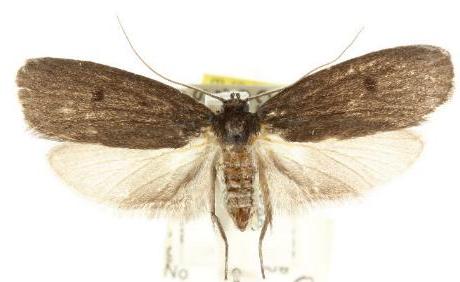
(Photo: courtesy of CSIRO/BIO Photography Group,
Centre for Biodiversity Genomics,
University of Guelph)
The Caterpillars of this species appear to live in the nests of
only one species of bird:
The Golden Shouldered Parrot (
Psephotus chrysopterygius ).
These birds nest in chambers in termite mounds.
The caterpillars live in a silk cocoon
at the bottom of the nest
feeding on the droppings of the nestlings,
thus keeping the nest clean.
The moths have an annual cycle synchronising with
that of the parrots.
The adult moths have brown forewings,
each with a dark mark near the middle.
The hindwings are white
each shading to brown at the tornus.
The wingspan is about 2.5 cms.
The moths are very hard to distinguish
from those of the related species
Trisyntopa neosophila.
The species has been found in
Queensland.
Further reading :
Ian F.B. Common,
Oecophorine Genera of Australia III:
The Barea Group and Unplaced Genera (Lepidoptera: Oecophoridae),
Monographs on Australian Lepidoptera Volume 8,
CSIRO Publishing (2000), pp. 17, 360-364, 366.
Penny Olsen,
Glimpses of Paradise: The Quest for the Beautiful Parrakeet,
National Library of Australia, 2007.
A. Jefferis Turner,
A Lepidopterous Scavenger Living in Parrots' Nests,
Transactions of the Entomological Society of London,
1923, pp. 170-175.
Henry Luke White,
Description of Eggs of the Golden-shouldered Parrot (Psephotus chrysopterigius),
The Emu,
Volume 22 (1922), pp. 98-99.
(updated 9 October 2002, 6 March 2017)






